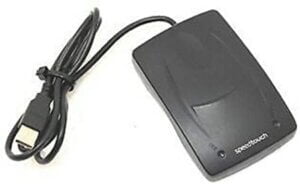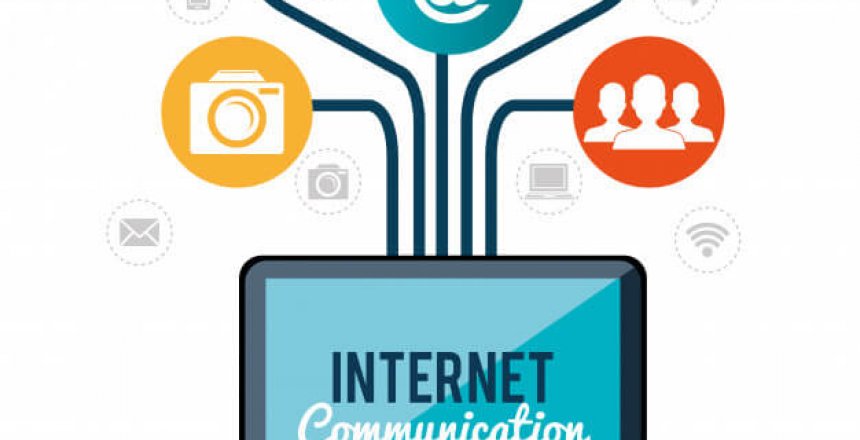The Internet is getting faster all the time, I remember my first modem connected to the Internet at 2400. Now most households are using fibre broadband, as well as 4G mobile broadband. Technology is improving every year.

Dial-up
Dial-up Internet consists of two modems. Modem or MOdulation-DEModulation is a device that converts computer language into analogue telephone language and vice versa.
Back in the days of Prestel, when traders needed a faster connection to see the latest stocks and shares on their TV, a split modem idea was introduced, the 1200/75 or 1.2Kbps down and 75 bps up.
As modems became faster, the principle remained the same, a fast down speed with a slower up speed. The fastest consumer modem was known as 56K for the 56K down speed and 33K up speed.

ISDN
ISDN or Industry Standards Digital Network was a telephone line replacement solely for digital connections. Instead of using analogue, ISDN removed some of the blocks that the analogue system had, and each customer would get ISDN2, which means that at every point, there would be 2 ports running at 64K, which could be combined to give 128K for both up and down speed.
ISDN also meant that you had two telephone lines, so you could make two calls at the same line over the same circuit, whereas analogue was limited to a single call per circuit.
Businesses that had more telephones would invest in ISDN30. ISDN30 was 32 lines, where 2 were used for signalling and 30 for calls. This meant that a number of ISDN2 ports in a building could be connected to a computer to do video conferencing. Additionally, the 30 lines could be aggregated to form a single 2M connection.

ADSL
ADSL or Asynchronous Digital Subscriber Line is what companies sell as unlimited or standard broadband.
Early broadband providers offered customers an ADSL modem that would behave like a fast USB dial-up modem that would give them broadband that way. Later routers were given out or sold. A router is a device with a modem inside it that provides the connection but also protects the user with an in-built firewall as users often were hacked because their computer lacked a firewall.
ADSL started off at speeds of 128K and the fastest speed if you are right near the exchange is 8M. ADSL is distance based, so the further you are from the exchange, the worse your performance becomes.
ISDN lines could not be upgraded to the faster ADSL system so ISDN customers had to pay to have ISDN removed.
When I worked at Demon, they had a DSLAM or Digital Subscriber Line Access Multiplexer in one of their data centres that would break out all the DSL lines from customers. These days the DSLAM is located in the exchange or in the new green cabinet when FTTC and FTTP is implemented in a fibre area.

SDSL
SDSL or Synchronous Digital Subscriber Line is a system like ADSL but is capable of much faster speeds, it uses a clocked signal like ISDN to keep everything synchronised and the up and down speed are the same.

VDSL
VDSL or Very high Digital Subscriber Line which is often sold under the name Fibre Broadband.
It uses the same principles of ADSL for a part fibre/part copper installation. The proper name for the fibre part is PON or Passive Optical Network.
VDSL originally had a maximum speed of 55M with an up speed of 3M. VDSL2 has a maximum speed of 200M with an up speed of 100M and the latest standard offers 300M down with 100M up.
The problem with VDSL is that the length of copper from your premises to the green box in the street affects the performance, that copper could be routed in the opposite direction to what you expect, taking a much longer route to the green box and you will get a slower speed from it.

FTTx
FTTx is the name for the technology used to deliver both part copper and full fibre to the customer.
In the case of FTTC Fibre To The Cabinet and FTTN Fibre To The Node, this is fibre most of the way to the customer. In distances where the cabinet is less then 300m from the customer, FTTC is used and greater than 300m, FTTN is used. Both are referred to as fibre broadband.
FTTP or Fibre To The Premises is also a broad term for two different delivery strategies:
- FTTB which is Fibre To The Building – Usually a leasehold building with multiple tenants (be they business or domestic) and then Ethernet cables run through the building to deliver Internet to each property.
- FTTH which is Fibre To The Home – Usually for freehold properties, each one gets their own fibre and equipment to give them access to the Internet.
FTTx delivered by BT Openreach is delivered asynchronous which gives a fast down speed and slow up speed. However, if the fibre is delivered by a different company the service is synchronous and provides both down and up speeds at the same rate.
FTTPoD or FoD
FTTPoD or Fibre To The Premises on Demand is a method of enabling the customer to increase their connection speed by utilising more fibre channels on demand.
Take a sports event where there are multiple camera angles in the game, each of those cameras is shooting very high quality video footage that is streamed over the Internet to the production studios so they can choose the best broadcast quality to broadcast to their customers. They would use multiple fibre channels for the time the games are at play and not use them for the rest of the year. They don’t pay all year round for the fibre they don’t use.
Ethernet Broadband
An extension of the FTTPoD idea is the ability to deliver Ethernet for the last mile, and technologies like 1000BASE and 10GBASE provide customers with 1Gb and 10Gb Ethernet from their provider.
Terabit Ethernet
Beyond 10Gb speeds there is Terabit Ethernet, delivering 25Gb on 25GBASE and 50Gb on 50GBASE with 100Gb on 100GBASE tested by BT in 2017 and with Vodafone in 2021.
However, there is 400GBASE being tested with the view of 1000GBASE or 1TBASE being tested in the near future.
Mobile Broadband
2G
1G cellular networks were analogue devices over an analogue network, this couldn’t support more than calls and were prone to people listening into calls using simple frequency scanners.
2G uses GPRS (General Packet Radio System) which is a set of digital protocols to enable mobile phones to communicate. This enabled users to send short messages in the form of subject lines of emails (this is how text messages are sent, with a limit of 160 characters, the limit of a subject line) and multimedia messages (these are sent in the body of the email) so providers could charge the earth for sending an email.
Since 2G was primarily designed for mobile fax, the speed is limited to 40Kb/s.
EDGE (Enhanced Data rates for GSM Evolution – with GSM standing for Global Standards for Mobile) increased the speed to 384kb/s.
3G
3G was originally designed for a top speed of 3.1Mb/s but with later technological improvements it could achieve a maximum speed of 42Mb/s in ideal conditions. However, real world speed was around 8Mb/s.
4G
4G, the logical replacement for 3G which used different frequencies to achieve up to 1Gb/s but in the real world cases it could achieve 10-30Mb/s.
5G
5G is considered in the industry as a stop-gap measure, since it is capable of 10Gb/s, however there needs to be closer masts and a lot more of them to make the technology practical.
Rollout has been hampered by Coronavirus and certain members of the public attacking engineers and destroying towers in the belief that 5G is causing Coronavirus.
6G
6G is the next generation mobile phone network standard, once the creases are ironed out and device processors are developed, this will be rolled out with much faster speeds and the ability to use mesh technology to use less masts and provide more coverage.
Currently data networks have a problem where signals clash with each other and this reduces power and availability. By implementing a mesh system, the signals broadcast are distributed so they don’t clash with each other which means speeds can be faster and more people can use the service.


